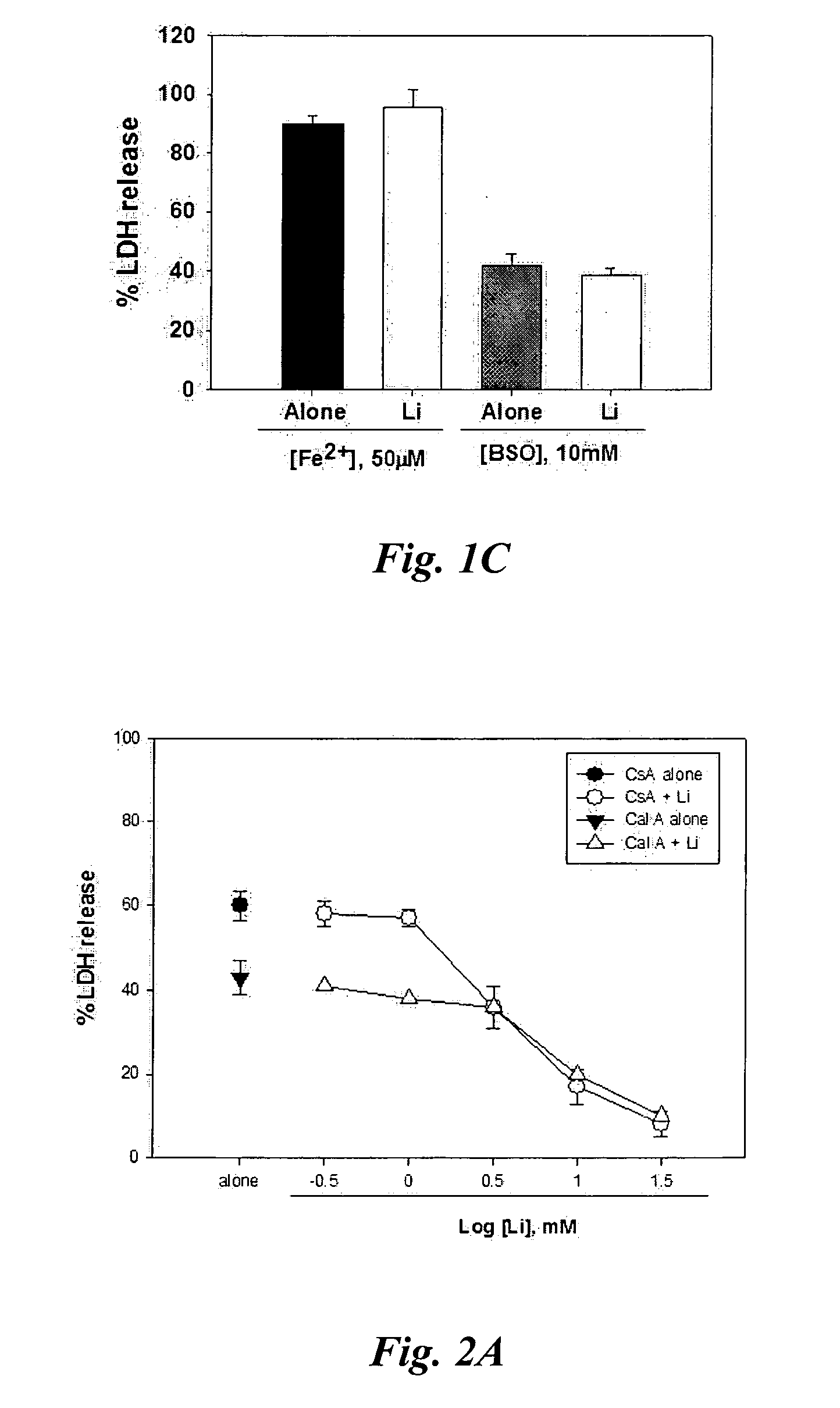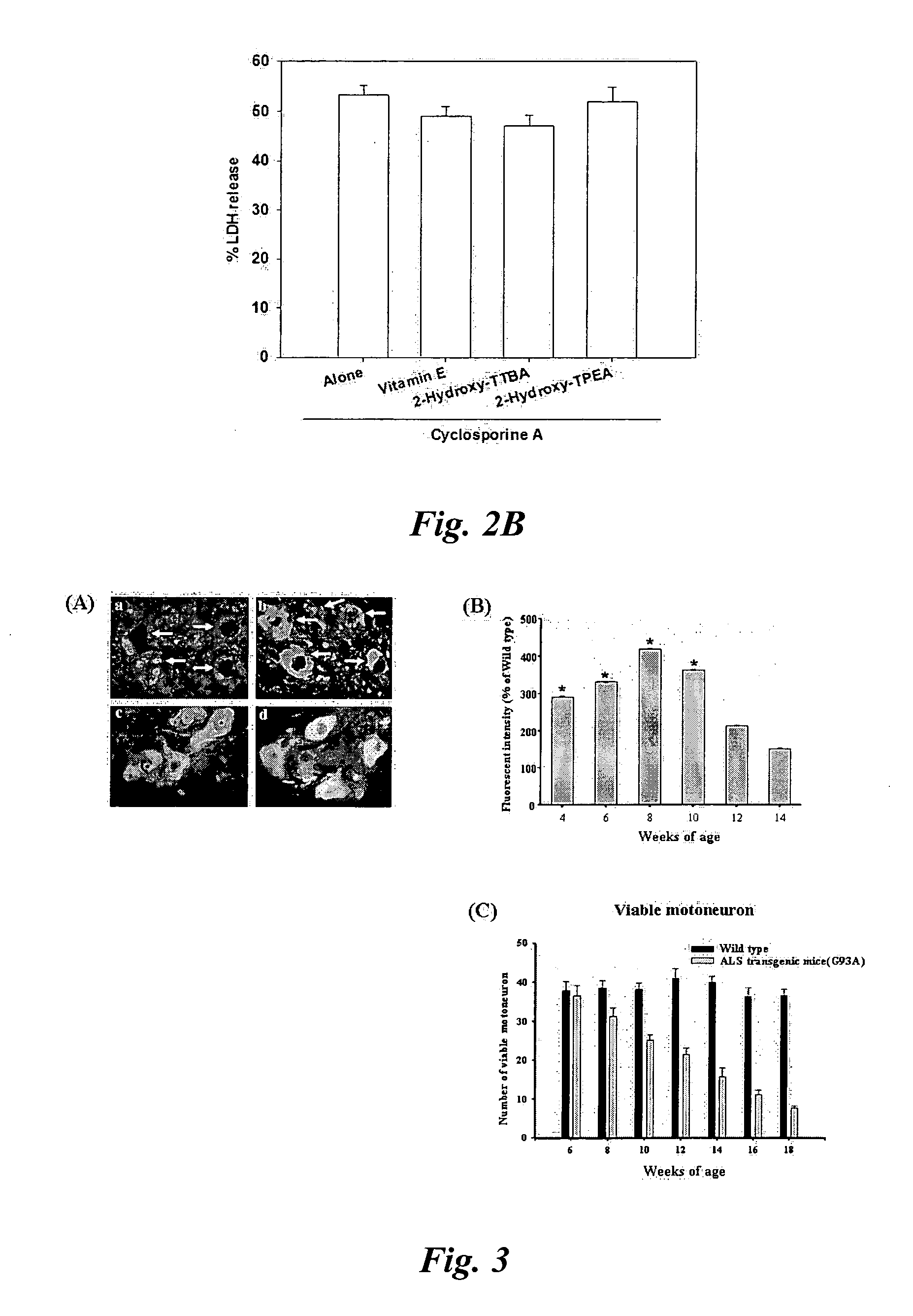Combination of cell necrosis inhibitor and lithium for treating neuronal death or neurological dysfunction
a cell necrosis inhibitor and cell technology, applied in the field of cell necrosis inhibitor and lithium, can solve the problems of cell dysfunction and degeneration, clinical trials of antioxidants such as vitamin e and acetyl-l-carnitine have failed to show beneficial effects in alzheimer's disease and parkinson's disease, and none of them have been beneficial in clinical trials of ischemic stroke patients, so as to block neuronal cell necrosis and reduce infarct volum
- Summary
- Abstract
- Description
- Claims
- Application Information
AI Technical Summary
Benefits of technology
Problems solved by technology
Method used
Image
Examples
example 1
Mixed Cortical Cell Cultures of Neurons and Glia
[0141] For mixed neuron-glia culture, mouse cerebral cortices were removed from brains of the 11-15 day-old-fetal mice (E11-15), gently triturated and plated on 24 well plates (2×105 cells / plate) precoated with 100 μg / ml poly-D-lysine and 4 μg / ml laminin. Cultures were maintained at 37° C. in a humidified 5% CO2 atmosphere. Plating media consist of Eagles minimal essential media (MEM, Earles salts, supplied glutamine-free) supplemented with 5% horse serum, 5% fetal bovine serum, 26.5 mM bicarbonate, 2 mM glutamine, and 21 mM glucose.
[0142] After 7-8 days in vitro (DIV 7-8), 10 μM cytosine arabinofuranoside (Ara-C) was included to halt overgrowth of glia. The drug treatment was carried on DIV 11-15 cortical cell culture. Overall neuronal cell injury was assessed by measuring amount of lactate dehydrogenase (LDH) released into the bathing medium 24 hr after neurotoxic insults as previously described (Koh and Choi, J Neurosci Methods 20...
example 2
Blockade of Free Radical Neurotoxicity by Vitamin E, Trolox, 2-Hydroxy-TTBA, 2-Hydroxy-TPEA, BAS, NBAS, CBAS, MBAS, FBAS, PBAS, NPM, NPPAA and TBAS
[0143] Oxidative stress was induced by exposing mixed cortical cell cultures containing neurons and glia (DIV 11-15) to 50 μM FeCl2, a hydroxyl radical-producing transition metal via a Fenton reaction, or 10 mM DL-buthionine-[S,R]-sulfoximine (BSO), a glutathione depleting agent. Widespread neuronal death was observed 24 hours later. Concurrent administration of 2-Hydroxy-TTBA or 2-Hydroxy-TPEA nearly completely blocked free radical neurotoxicity at doses as low as 0.3 μM (FIGS. 1A & 1B). Administration of vitamin E prevented Fe2+-induced free radical neurotoxicity at higher doses. This implies that 2-Hydroxy-TTBA or 2-Hydroxy-TPEA is a potent neuroprotectant against oxidative stress. Neuroprotective effects of several cell necrosis inhibitors were analyzed as IC50 value that showed 50% protection against Fe2+-induced free radical neurot...
example 3
[0145] Prevention of Neuronal Cell Apoptosis by Li+
[0146] Cortical cell cultures containing neurons and glia at 10-12 days in vitro (DIV 10-12) were exposed to 20 μM cyclosporine A (CsA) or 10 nM caliculin A (cal A). Neurons underwent widespread apoptosis 24 hr later as previously reported (McDonald et al., 1996; Ko et al., 2000). Concurrent administration of Li+ dose-dependently attenuated neuronal cell apoptosis at doses of 3-30 mM (FIG. 2A). Cyclosporine A-induced neuronal cell apoptosis was not attenuated by inclusion of vitamin E, 2-hydroxy-TTBA, or 2-hydroxy-TPEA (FIG. 2B). This implies that Li+ and the neuroprotective drugs (vitamin E, trolox, BAS, CBAS, FBAS, TBAS, PBAS, MBAS, NPAA, NPPAA, 2-Hydroxy-TTBA, and 2-Hydroxy-TPEA) selectively prevent neuronal cell apoptosis and free radical-mediated necrosis, respectively.
PUM
| Property | Measurement | Unit |
|---|---|---|
| oxidative stress | aaaaa | aaaaa |
| blood brain barrier permeability | aaaaa | aaaaa |
| concentrations | aaaaa | aaaaa |
Abstract
Description
Claims
Application Information
 Login to View More
Login to View More - R&D
- Intellectual Property
- Life Sciences
- Materials
- Tech Scout
- Unparalleled Data Quality
- Higher Quality Content
- 60% Fewer Hallucinations
Browse by: Latest US Patents, China's latest patents, Technical Efficacy Thesaurus, Application Domain, Technology Topic, Popular Technical Reports.
© 2025 PatSnap. All rights reserved.Legal|Privacy policy|Modern Slavery Act Transparency Statement|Sitemap|About US| Contact US: help@patsnap.com



